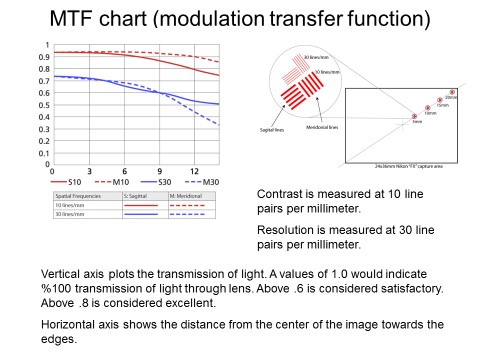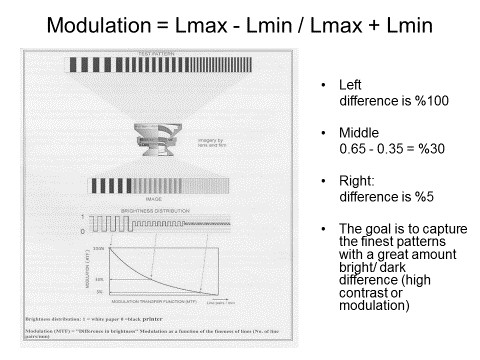Lens MTF detail
Jul 1, 2017 06:36:50 #
Jul 1, 2017 07:03:01 #
Does anyone remember when photography magazines would test new lenses.
Jul 1, 2017 07:06:12 #
billnikon
Loc: Pennsylvania/Ohio/Florida/Maui/Oregon/Vermont
aflundi wrote:
I know MTFs are somewhat "flexible", but it just occurred to me that I don't remember ever seeing if there is a wavelength requirement. Specifically, when the MTF is calculated, is it, or can it be done with a narrow frequency band, or is there a "requirement" that a flat white light including the entire visible frequency band be used?
IMHO, the OP SHSO MFT.
Jul 1, 2017 07:39:29 #
I did some research into MTF charts when I put together a PowerPoint presentation for my camera club once. I don't remember anything about specific wavelengths being used. I think the full spectrum of light was used. These are two of the slides I put in the presentation. Look at the bottom slide. They are measuring the contrast between white and black line pairs. The line pairs become more dense going from left to right. It becomes more difficult for the lens to distinguish the difference between the white and black lines. The lens is "seeing" less contrast between the lines. The upper row is the test pattern. The second row is what the lens is seeing. You can see how there is a lot of contrast at the left end less contrast at the right end.
In the upper chart, the horizontal axis is the distance in millimeters starting at the center of the lens. The lines on the chart are dropping because the lens cannot resolve the lines pairs as well towards the edges of the lens.
In the upper chart, the horizontal axis is the distance in millimeters starting at the center of the lens. The lines on the chart are dropping because the lens cannot resolve the lines pairs as well towards the edges of the lens.


Jul 1, 2017 08:04:06 #
Jul 1, 2017 08:04:33 #
rjaywallace wrote:
"Micro Four Thirds", but the OP should have spelled it out.
MTF is not the same as MFT -
Jul 1, 2017 08:15:02 #
lmTrying
Loc: WV Northern Panhandle
billnikon wrote:
IMHO, the OP SHSO MFT.
Good one, Bill. As a John Deere parts man, I liked to screw with techs in Iowa who always used acronyms in their printed communications.
Got to have some fun along the way. Learned that from M.A.S.H.
Jul 1, 2017 08:19:13 #
lmTrying
Loc: WV Northern Panhandle
bamfordr wrote:
And, of course, there is LSMFT
lololol
Remembered the letters, just had to think a couple of seconds for what they stood.
Jul 1, 2017 08:32:37 #
StanRP
Loc: Ontario Canada
aflundi wrote:
I know MTFs are somewhat "flexible", but it just occurred to me that I don't remember ever seeing if there is a wavelength requirement. Specifically, when the MTF is calculated, is it, or can it be done with a narrow frequency band, or is there a "requirement" that a flat white light including the entire visible frequency band be used?
Hi,
This is a link to an article on MTF on the NIKON website.
http://www.nikonusa.com/en/learn-and-explore/a/products-and-innovation/what-is-a-lens-mtf-chart-how-do-i-read-it.html
StanRP
Jul 1, 2017 09:29:59 #
bamfordr wrote:
And, of course, there is LSMFT
And let's not forget MTBF.
http://whatis.techtarget.com/definition/MTBF-mean-time-between-failures
Jul 1, 2017 09:40:44 #
lmTrying
Loc: WV Northern Panhandle
jerryc41 wrote:
After reading the link, I'd call it Mean Time Before Failure. Because after Failure there usually is no return to service.
Jul 1, 2017 09:42:14 #
rjaywallace wrote:
Aha! An arcane mutiny...
Again, the OP might have had the courtesy not to assume we would all know what was being referred to.
Again, the OP might have had the courtesy not to assume we would all know what was being referred to.
Even if he had spelled out "Modulation Transfer Function" it still doesn't mean a thing to me ;-)
Best I can tell, it's important when you buy a lens, but once you have lens, you're stuck with it?
Since I don't understand it, I don't worry about it.
(Don't get me wrong, that's NOT my attitude for everything, there are other things that I will research and ask questions about till I DO understand them!)
Jul 1, 2017 09:52:32 #
lmTrying wrote:
After reading the link, I'd call it Mean Time Before Failure. Because after Failure there usually is no return to service.
For a long term use item, wouldn't they just repair it and continuing using it?
More info -
http://world-class-manufacturing.com/KPI/mtbf.html
Jul 1, 2017 09:56:30 #
aflundi
Loc: Albuquerque, NM
OP here. Sorry for not spelling out MTF. I figured it is so fundamental to photography, it would be virtually universally known, and if a person didn't know what an MTF was, they would exercise a bit of restraint and read to learn rather than feel compelled to waste bandwidth and give a useless answer. Sorry. My bad. So, here it is: MTF == Modulation Transfer Function.
Thanks to those that provided links to basic explanations for those that didn't know what an MTF was. Maybe it'll reduce the noise next time an MTF comes up. (or not. )
)
So, as a reminder, the question was whether a vendor might calculate, or if you are Zeiss, actually measure, the MTF using a single wavelength or a narrow band, versus a flat, white-light, continuous spectrum for the calculations or measurement.
I think this would be important to know because if something other than a full flat spectrum is used, the results would look deceptively good, and might well be meaningless. It might also mean that the interpretation of an MTF might well be completely different than the usual.
Virtually every time MTFs are explained, a caveat is thrown in that MTFs from different vendors can't be compared. Is this possibly why? It might explain why Canon MTFs from Canon often look much worse than those from other vendors. Is it possible that Canon is the only one doing an honest flat white spectrum calculation?
Lens Rentals has an optical tool for measuring MTFs. Do they use a flat white light source, or a narrow-band laser? Anyone here have any insights?
Thanks to those that provided links to basic explanations for those that didn't know what an MTF was. Maybe it'll reduce the noise next time an MTF comes up. (or not.
 )
)So, as a reminder, the question was whether a vendor might calculate, or if you are Zeiss, actually measure, the MTF using a single wavelength or a narrow band, versus a flat, white-light, continuous spectrum for the calculations or measurement.
I think this would be important to know because if something other than a full flat spectrum is used, the results would look deceptively good, and might well be meaningless. It might also mean that the interpretation of an MTF might well be completely different than the usual.
Virtually every time MTFs are explained, a caveat is thrown in that MTFs from different vendors can't be compared. Is this possibly why? It might explain why Canon MTFs from Canon often look much worse than those from other vendors. Is it possible that Canon is the only one doing an honest flat white spectrum calculation?
Lens Rentals has an optical tool for measuring MTFs. Do they use a flat white light source, or a narrow-band laser? Anyone here have any insights?
Jul 1, 2017 10:02:22 #
Or possibly LSMFT.
--Bob
--Bob
OddJobber wrote:
Modulation transfer function. MTF, not MFT.
If you want to reply, then register here. Registration is free and your account is created instantly, so you can post right away.





